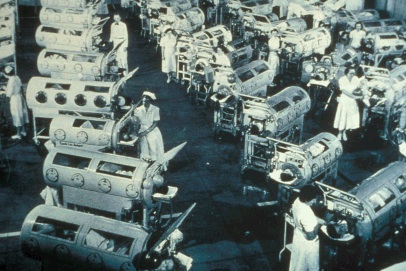60 years of the polio vaccine
We've edited down a film made in 1961 about the first mass vaccination campaign against polio in the UK. You can see the original here: https://wellcomecollection.org/works/h7yw8p82
Poliomyelitis is a virus that has infected humans since the earliest of times – sometimes causing permanent paralysis. It mainly affects children under the age of five. Polio was known to be an infectious disease since Karl Landsteiner and Erwin Popper’s famous experiments in 1908 showed that polio could be transmitted between animals. It is transmitted from human to human, typically through drinking water contaminated with faeces containing the virus.
The polio virus can enter the body through the gut, damaging the nervous system in a matter of hours. This can lead to paralysis, and if the muscles that control breathing are paralysed, this can cause death from asphyxiation.
In the past iron-lungs supported breathing, allowing time for patients to recover from their infection, but sometimes the nerve-damage and paralysis were permanent.
Hundreds of thousands of people used to catch polio every year with one in 200 infections leading to irreversible paralysis and 5 to 10% of these people dying when their breathing muscles became immobilised.
Polio still cannot be cured but it can be prevented by vaccination.
Thanks to vaccination, polio cases have decreased by over 99% since 1988, from an estimated 350,000 cases then, to 416 reported cases worldwide in 2013. The reduction is the result of the global effort to eradicate the disease.
Read more: https://www.understandinganimalresearch.org.uk/news/sixty-years-of-the-polio-miracle-vaccine/
Last edited: 6 April 2022 09:46

